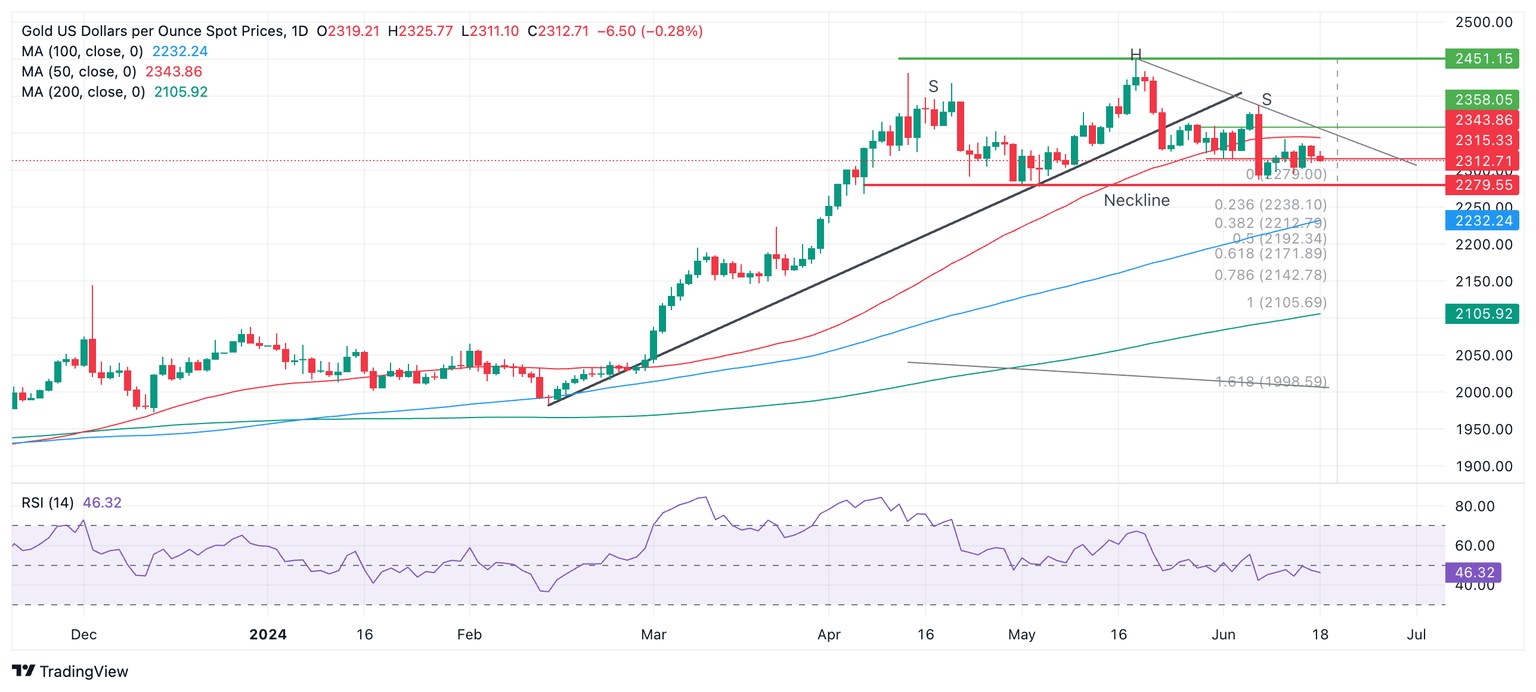Gold retreats despite survey showing healthy central bank demand
- Gold edges lower as risk-on dominates the market, preferencing riskier assets over safe-havens.
- A survey by the World Gold Council expects central-bank demand to remain sturdy in 2024, adding a backwind to Gold price.
- XAU/USD continues forming a bearish Head-and-Shoulders pattern on the daily chart.

Gold (XAU/USD) price edges lower, exchanging hands in the $2,310s on Tuesday as an overall positive risk tone to markets weighs on the safe-haven precious metal. The decline comes despite a survey from the World Gold Council (WGC) showing respondents expect demand to remain strong in 2024.
Gold retreats as risk-on dominates markets
Gold declines over a quarter of a percent on Tuesday as demand for riskier assets diverts attention away from the safety-linked Gold.
US stock indexes reached new all-time highs on Monday on the back of another rally in tech stocks. The good mood continued into the Asian session when most bourses in the East also booked gains.
Current market expectations see the US Federal Reserve (Fed) making a 0.25% cut to the Fed Funds Rate by September, as roughly 55% probable. This comes despite the Fed upping its estimate of the future path of interest rates at its June meeting – a negative for non-yielding Gold.
Gold survey shows central-bank buying bonanza to last
Central banks are purported to now account for about a quarter of total Gold purchases, and demand from the sector is likely to remain strong in 2024, according to a survey by the World Gold Council, published on Tuesday.
The WGC’s “2024 Central Banks Gold Reserves Survey” results showed that 81% of respondents expected overall central-bank Gold reserves to increase in 2024, 19% for them to remain the same, and none to fall.
This was higher than the 2023 survey results, which showed 71% expected overall central bank reserves to increase, against 28% that they would remain unchanged and 1% that they would fall.
It was the highest percentage of respondents who expected reserves to increase since the WGC first started the survey in 2019.
When asked whether they expected their central bank specifically to increase its Gold reserves in 2024, 29% said they thought it would, 68% thought it would remain unchanged and only 3% expected it to fall. This was also the highest percentage of affirmations for the question since the survey began.
The most important driver for central banks to hoard Gold was as a “long-term store of value/inflation hedge” according to the survey, with 42% rating it as a “highly relevant factor” in its decision-making process.
The survey findings suggest longer-term demand for Gold from central banks is likely to remain robust – a supportive factor for the Gold price.
Technical Analysis: Gold forms Head-and-Shoulders top
Gold appears to be completing a bearish Head-and-Shoulders (H&S) price pattern on the daily chart. These patterns tend to occur at market tops and signal a change of trend.
XAU/USD Daily Chart

The H&S on Gold has completed a left and right shoulder (labeled “S”) and a “head” (labeled “H”). The so-called “neckline” of the pattern appears to be at the $2,279 support level (red line).
The declining momentum signaled by the Relative Strength Index (RSI) during its development corroborates the pattern.
A decisive break below the neckline would validate the H&S pattern and activate downside targets. The first more conservative target would be $2,171, calculated by taking the 0.618 Fibonacci ratio of the height of the pattern and extrapolating it lower from the neckline. The second target would be at $2,106, the full height of the pattern extrapolated lower.
A break above $2,345, however, would bring the H&S into doubt and could signal a continuation higher, to an initial target at the $2,450 peak.
Interest rates FAQs
Interest rates are charged by financial institutions on loans to borrowers and are paid as interest to savers and depositors. They are influenced by base lending rates, which are set by central banks in response to changes in the economy. Central banks normally have a mandate to ensure price stability, which in most cases means targeting a core inflation rate of around 2%. If inflation falls below target the central bank may cut base lending rates, with a view to stimulating lending and boosting the economy. If inflation rises substantially above 2% it normally results in the central bank raising base lending rates in an attempt to lower inflation.
Higher interest rates generally help strengthen a country’s currency as they make it a more attractive place for global investors to park their money.
Higher interest rates overall weigh on the price of Gold because they increase the opportunity cost of holding Gold instead of investing in an interest-bearing asset or placing cash in the bank. If interest rates are high that usually pushes up the price of the US Dollar (USD), and since Gold is priced in Dollars, this has the effect of lowering the price of Gold.
The Fed funds rate is the overnight rate at which US banks lend to each other. It is the oft-quoted headline rate set by the Federal Reserve at its FOMC meetings. It is set as a range, for example 4.75%-5.00%, though the upper limit (in that case 5.00%) is the quoted figure. Market expectations for future Fed funds rate are tracked by the CME FedWatch tool, which shapes how many financial markets behave in anticipation of future Federal Reserve monetary policy decisions.
Author

Joaquin Monfort
FXStreet
Joaquin Monfort is a financial writer and analyst with over 10 years experience writing about financial markets and alt data. He holds a degree in Anthropology from London University and a Diploma in Technical analysis.

















